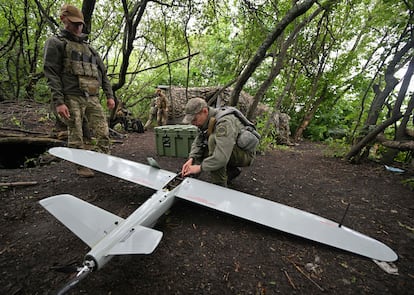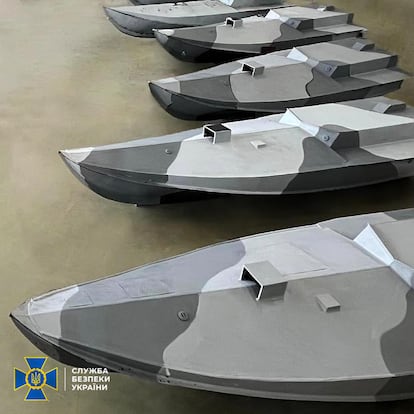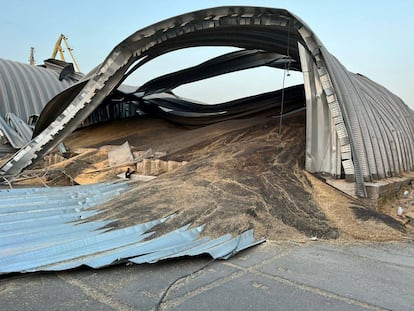From cardboard bomb drones to long-range missiles: New Ukrainian-designed weapons target Russia
Kyiv is producing a new generation of weapons, including cruise missiles, to strike beyond its borders and reduce dependence on its international allies


Making a virtue out of necessity is a useful mantra when a military superpower wants to wipe you off the map. Ukraine has been at war with Russia since 2014, when the Kremlin supported a separatist uprising in the Donbas region and annexed the Crimean Peninsula. Moscow’s full-scale invasion, launched in February 2022, has forced Ukraine to develop weaponry more rapidly, an industry largely based on private initiative to produce cheaper armaments, reduce Kyiv’s dependence on its international allies, and to strike on Russian soil.
One of the most significant changes of the conflict in 2023 is that Ukraine has taken the war to Russia. Ukrainian drones are launched at military targets and infrastructure in Russia on an almost daily basis. Even Moscow, over 300 miles from the Ukrainian border, has been attacked by drone bombs. Kyiv’s NATO allies have drawn a red line on such operations, stating that the weaponry they supply should not be used to attack Russian territory. That is why the Ukrainian Armed Forces are using aircraft designed by national companies.
At least two drones recently incorporated into the Ukrainian Army have been confirmed as part of the arsenal used against Moscow: the UJ-22 drone, made by Ukrjet, and the Bober, the producers of which have not been made public. The UJ-22 is a reconnaissance device, with a range of 500 miles, which has been converted into a bomb drone. The Bober has a range of over 600 miles each device costs around €100,000 ($106,500) to make. The Morok has a similar range to the Bober and although it is at a less developed stage, it has already been used against targets in Crimea.
Another unmanned craft produced in Ukraine, unveiled publicly in August, are drones made of cardboard, which makes them more difficult to detect by radar and drastically reduces the cost of production. According to military media, these devices cost no more than €3,000 ($3,200). Ukraine had been using cardboard drones produced by Australian company Sypaq, but the Ukrainian Security Services (SSU) claimed that the August 27 attack on the Russian Kursk airbase was carried out with a new model of its own.
Cardboard drones cannot carry heavy explosive charges: in the case of Sypaq models, the limit if five kilograms. In the Kursk attack, the aircraft was armed with fragmentation mines, which release small projectiles over a wide radius that, while not completely destroying the target — in this case, Russian bomber aircraft — do cause significant damage. These cardboard drones have a range of up to 90 miles. All indications are that they were launched from within Russia’s borders. The SSU claimed that the strike against the Kursk base was carried out together with a Russian paramilitary group that opposes Vladimir Putin. The head of Ukrainian military intelligence, Kyrylo Budanov, claimed that the drones that attacked the Pskov air base, 700 kilometers from Ukraine, on August 30 were also launched from inside Russia.

The main advantage of the Ukrainian arms industry over its Russian counterpart is the autonomy of the production companies and of military units at the front. In early September, EL PAÍS visited a secret drone development workshop of the Ukrainian 92nd Mechanized Brigade in the province of Kharkiv. The head of the unit, codenamed, Gansk, stressed that the Russian industrial model has a larger public budget. But because it is very hierarchical, improvements and innovation are slow to come into effect.
Gansk illustrated the point with examples of ongoing cooperation with private enterprises in improving the adaptation of explosives to commercial drones or even to prototypes they develop in their workshop, such as two models made of polystyrene. But the crown jewel of the 92nd Mechanized Brigade’s armory is the Vampire, a large six-propeller drone produced by a group of Ukrainian companies that since August have been delivered in bulk to the front lines. The Vampire can carry 15 kilograms of bombs, which are dropped on the target.
Other strategic drones in regular use on the battlefield are the Shark, a high-altitude reconnaissance aircraft made by Ukrspectsystems, and the small front-camera drones produced by the company Air Unit, which are widely used as bombers against enemy positions. Air Unit explained to the Ukrainian media last month that it intends to increase the effectiveness of these devices to over 20%. According to the company, the Russian Lancet drone bombs, one of the most-used weapons in Moscow’s arsenal, have an efficiency of 30%. According to The Economist, between 35% and 40% of Ukrainian drone bombs hit their targets.

Ukraine’s first cruise missile
Ukrainian President Volodymyr Zelenskiy held a meeting on 28 August with his Cabinet and leading domestic arms producers to seek ways for manufacturing to be “maximized.” Zelenskiy singled out the production of ammunition, drones, armor, and missiles. As far as armor and heavy weapons are concerned, Ukraine’s greatest success has been to introduce its Bohdana self-propelled howitzer — with a range of over 25 miles — to the battlefield in record time. The president himself delivered the most eagerly awaited new on August 31: the first Ukrainian cruise missile has already been successfully tested. The rocket, according to Zelenskiy, hit its target at a distance of 430 miles.
This is a leap forward in Ukrainian military power because so far Kyiv’s NATO allies have withheld long-range weaponry — with the exception of the British Storm Shadow — for fear that these missiles will be used against Russian territory. Last Wednesday, an attack with 10 cruise missiles was launched against a Russian shipyard in Sevastopol, in the Crimean Peninsula, damaging two warships, according to the Russian Defense Ministry. Ukrainian Air Force Commander Mykola Oleschuk implied that the missiles used were Storm Shadows.
Oleksiy Danilov, secretary of the National Security and Defense Council of Ukraine, told Radio Ukraine on September 2 that rapid progress was being made and that, in the not-too distant future, the range of domestic cruise missiles would increase to “1,500 kilometers [930 miles] inside Russian territory.” “Sevastopol is waiting, Kamchatka is waiting, Kronstadt is waiting,” Danilov wrote on his social networks. Sevastopol, in Crimea, is the primary base for Russia’s Black Sea fleet; Kamchatka is a peninsula in eastern Russia and Kronstadt is a port city neighboring St. Petersburg.

It was initially believed that such a long-range missile was responsible for the August 23 destruction of a Russian S-400 anti-aircraft battery in Crimea. The nearest Ukrainian-controlled territory to the S-400 position was a little over 100 miles away. The confusion was generated by Danilov himself when he confirmed that “a new missile” was used in the attack. Ukrainian military analysts and media subsequently reported that the missile was an evolution of the Ukrainian Neptun anti-ship missile, which has been adapted to hit targets on land.
Ukraine’s advances in maritime warfare have been significant because the Russian Navy dominates the Black Sea, Ukraine’s main commercial outlet. Two of the most audacious operations launched by the SSU have been carried out with a new nautical drone bomb developed by Kyiv and baptized the “Sea Baby.” In July, this device was used to partially destroy the Kerch Bridge, the only land link connecting occupied Crimea with Russian territory. In August, a Sea Baby traveled more than 400 nautical miles undetected to hit the Russian ship Olengorskii Gorniak in the port of Novorossiysk, in the Russian province of Krasnodar. The Sea Baby was also employed in Wednesday’s attack on the Sevastopol shipyard.
Sign up for our weekly newsletter to get more English-language news coverage from EL PAÍS USA Edition
Tu suscripción se está usando en otro dispositivo
¿Quieres añadir otro usuario a tu suscripción?
Si continúas leyendo en este dispositivo, no se podrá leer en el otro.
FlechaTu suscripción se está usando en otro dispositivo y solo puedes acceder a EL PAÍS desde un dispositivo a la vez.
Si quieres compartir tu cuenta, cambia tu suscripción a la modalidad Premium, así podrás añadir otro usuario. Cada uno accederá con su propia cuenta de email, lo que os permitirá personalizar vuestra experiencia en EL PAÍS.
¿Tienes una suscripción de empresa? Accede aquí para contratar más cuentas.
En el caso de no saber quién está usando tu cuenta, te recomendamos cambiar tu contraseña aquí.
Si decides continuar compartiendo tu cuenta, este mensaje se mostrará en tu dispositivo y en el de la otra persona que está usando tu cuenta de forma indefinida, afectando a tu experiencia de lectura. Puedes consultar aquí los términos y condiciones de la suscripción digital.
More information
Archived In
Últimas noticias
Maduro pleads not guilty before the federal court in New York: ‘I am still the president of Venezuela’
A new test can detect Alzheimer’s from a finger prick
UN team enters Sudanese city of El Fasher after paramilitary massacre: ‘It’s like a ghost town’
A recipe for resistance: Indigenous peoples politicize their struggles from the kitchen
Most viewed
- Gilles Lipovetsky: ‘If you want to live better and fall in love, take Prozac, don’t look to philosophy’
- Alain Aspect, Nobel laureate in physics: ‘Einstein was so smart that he would have had to recognize quantum entanglement’
- Alvin Hellerstein, a 92-year-old judge appointed by Bill Clinton, to preside over Maduro’s trial in New York
- Why oil has been at the center of Venezuela-US conflicts for decades
- Maduro’s downfall puts China’s relationship with Venezuela to the test










































